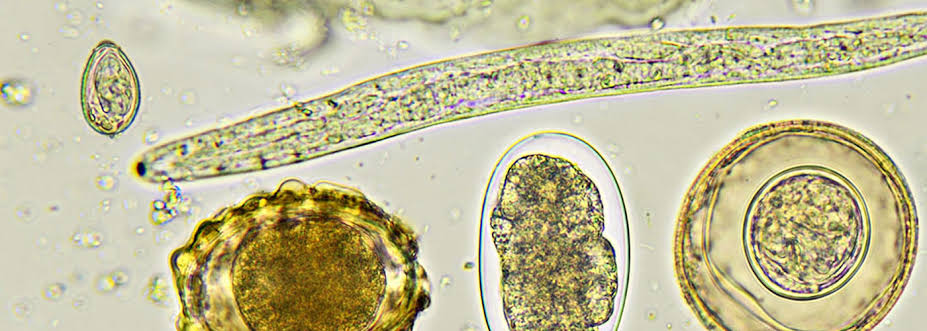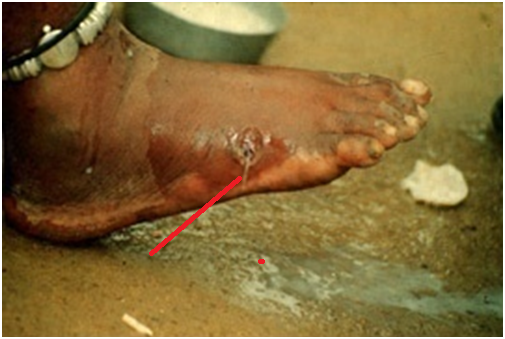Parasitology is the study of parasites and their interaction with other organisms (i.e. their hosts). It is the study of parasites, their ecology, transmission and life cycle. The study of parasites is as ancient as mankind as man became conscious of his immediate environment. The field of Parasitology was fully established and widely appreciated in the early 1860’s. During this period, scientists as at the time postulated that protozoa and helminthes (which are both parasites) were actually responsible for some diseases of man and animals. Diseases and infections caused by parasites are by far amongst the top-most ever-present malady that man and his domestic animals encounter on almost daily basis aside bacterial, viral or fungal infections.
The disease burden of parasitic infections cannot be over-emphasized, and this menace is experienced most in tropical developing countries where both natural and man-made activities has made it possible for the parasites to continue their devastating effects almost unperturbed. For the purpose of this book, we shall concern ourselves with the medical discipline of Parasitology, and this has to do with parasitic protozoa (such as Plasmodium), helminthes (Tapeworm) and arthropods (Tick). Though some bacteria, fungi and viruses are pathogenic, and cause disease and infections in humans; these microorganisms are not covered in the study of Parasitology even though they can coexist parasitically with man. Not all parasites are microorganisms (such flea and tick) but all microorganisms are parasitic in nature, and they cause harm or disease in their host.
There are about 10,000 species of protozoal parasites with different life cycles, and that cause a variety of diseases in human beings and animals. Parasitic infections (example malaria) accounts for billions of resource waste in most parts of the world where they are a great source of concern and burden to health practitioners because they account to a colossal amount of mortality and morbidity in these regions (in the African and Asian continent where these organisms are most prevalent). Understanding the life cycles of these parasites and the mechanisms of their pathogenesis is critical to the containment of the diseases that they cause. There spread and transmission in any population can also be better controlled; and a reduction in economic wastages due to them will be achieved as well.
Parasites are living organisms that establish a physiological association with the tissues on the surface or inside the body of another organism called the host (example man, animal and host). The association between a parasite and a host is usually one that inflicts some level of injury and discomfort to the host, and this occasionally results to a disease or infection in the affected organism or host. This kind of association or relationship between a parasite and a host is called parasitism. In such relationships, only the parasites benefit while the host is often left diseased in the cause of the relationship. The host does not benefit but rather suffers the sole dependability of the parasite on it for food, water, shelter and protection. The host of a parasite can be definitive host, intermediate host or reservoir host.
Reservoir hosts store or harbour the parasite, and they serve as medium via which other susceptible human or animal hosts become infected by the protozoa. Definitive hosts are hosts that maintain the mature infective form of the parasite; and in some cases some clinically important parasites have humans as their only definitive hosts (example Trichinella spiralis). Sexual development of parasites takes place in the definitive host. Intermediate hosts are the second hostsof a parasite apart from the definitive host; and they are known to substitute with the definitive host and are usually known to harbour some reproductive stages of the parasite like the definitive host. Asexual development of parasites takes place in the intermediate host.
In establishing a disease condition,parasites usually replicate intracellularly (i.e. inside the cells of its human host) as is seen in the Plasmodium species which solely multiply in the blood or extracellularly (outside the cells of its host) as is seen in Giardia species that develop in the lumen of the intestinal tract. There are a wide variety of parasites or protozoa that parasitize humans and cause diseases or parasitic infections (Table 1); and some of these infections are subclinical in nature while the others are symptomatic and are presented with some clinical episodes that make the individual seek for medical help. The parasites that infect man and other animals are usually found all over the world and close to their immediate environments; and such organisms constitute one of the world’s greatest danger to the socioeconomic and wellbeing of humans.
Table 1: Some clinically important parasitesand their clinical features
| Parasite | Group | Morphological form | Host | Disease |
| Ascaris lumbricoides | Roundworm/Intestinal nematode | Eggs and adult worms | Humans | Ascariasis |
| Ancylostoma duodenale | Intestinal hookworm | Eggs | Humans | Hookworm disease |
| Acanthamoeba species* | Amoeba | Cyst and trophozoite | — | Amoebiasis |
| Balantidium coli* | Ciliate | Cyst and trophozoite | Humans and pig | Balantidial dysentery |
| Brugia species* | Filarial nematode | Microfilaria | Cat, humans and monkey | Lymphatic filariasis |
| Clonorchis sinensis* | Trematodes/fluke | Eggs | Cat, pig, dog, humans, mouse, fish and snail | Clonorchiasis |
| Cyclospora cayetanensis* | Intestinal coccidian | Oocysts | Humans | Diarrhea in immunocompromised host |
| Cryptosporidium parvum* | Intestinal coccidian | Oocysts | Humans, livestock, domestic and wild animals | Cryptosporidiosis and diarrhea in immunocompromised host |
| Dracunculus medinensis* | Guinea worm or filarial nematode | Larva | Humans and Cyclops | Dracunculiasis |
| Diphyllobothrium latum* | Tapeworm/cestode | Eggs | Cat, humans, dog, crustaceans and fish | Diphyllobothriasis |
| Entamoeba histolytica* | Amoebae | Cyst and trophozoite | Humans | Amoebic dysentery |
| Enterobius vermicularis | Threadworm/intestinal nematode | Eggs and adult worms | Humans | Enterobiasis |
| Echinococcus granulosus | Tapeworm/cestode | Larva | Sheep, humans, dog, and wild animals | Echinococcosis |
| Fasciolopsis buski | Trematodes/fluke | Eggs | Snails, humans and pig | Fasciolopsiasis |
| Fasciola hepatica | Trematodes/fluke | Eggs | Snail, humans and cattle | Fascioliasis |
| Giardia lamblia* | Flagellate | Trophozoite and cyst | Humans | Giardiasis |
| Hymenolepis nana | Tapeworm | Eggs | Humans | Hymenolepiasis |
| Isospora belli* | Intestinal coccidian | Oocysts | Humans | Isosporiasis and diarrhea in immunocompromised host |
| Leishmania species* | Flagellates | Amastigote | Sandfly, humans, dog and rodent | Leishmaniasis |
| Loa loa | Filarial nematode | Microfilaria | Chrysops and humans | Loiasis or calabar swelling |
| Necator americanus | Hookworm/intestinal nematode | Eggs | Humans | Hookworm disease |
| Onchocerca volvulus | Filarial nematode | Microfilaria | Blackfly and humans | River blindness or onchocerciasis |
| Opisthorchis viverrini | Trematodes/fluke | Eggs | Snail, humans, cat and fish | Opisthorchiasis |
| Paragonimus westermani | Trematodes/fluke | Eggs | Snail, humans, carnivores, crab and other crustaceans | Paragonimiasis |
| Plasmodium species* | Blood/tissue coccidian | Trophozoite, schizont and gametocyte | Mosquitoes and humans | Malaria |
| Schistosoma species | Trematodes/fluke | Eggs | Snail, humans, cat, rodent and cattle | Intestinal & urinary schistosomiasis |
| Strongyloides stercoralis | Intestinal nematode | Larva | Humans | Strongyloidiasis |
| Taenia solium | Tapeworm | Eggs | Pig and humans | Taeniasis |
| Taenia saginata | Tapeworm | Eggs | Cattle and humans | Taeniasis |
| Trichinella spiralis | Filarial nematode | Larva | Humans, pig, rodent and wild animals | Trichinellosis |
| Trichomonas vaginalis* | Flagellate | Trophozoite | Humans | Vaginitis (in females) and urethritis (in males) |
| Trypanosoma species* | Flagellate | Trypomastigote | Tsetse fly, humans, triatomine bugs, cat and dog | African trypanosomiasis (sleeping sickness) and American trypanosomiasis (Chagas disease) |
| Toxoplasma gondii* | Blood/tissue coccidian | Oocysts | Humans, cat, pigs, birds and rodents | Toxoplasmosis |
| Trichuris trichiura | Whipworm/intestinal nematode | Eggs | Humans | Trichuriasis |
| Wuchereria bancrofti | Filarial/tissue nematode | Microfilaria | Mosquitoes and humans | Bancroftian filariasis (elephantiasis) |
Most of these parasites are usually located and distributed in the tropical regions of the world because of some peculiar features of these areas. Typically examples include the Plasmodium parasites which are inherently found in tropical regions of the world especially in the African continent (Nigeria for example). Plasmodium which causes malaria in man has over the years even now impacted negatively on the wellbeing and socioeconomic welfare of human beings, and this scenario has resulted to the high morbidity and mortality rates recorded in malaria disease cases across Africa. Most parasitic diseases (malaria) are major diseases of the tropical and subtropical regions; and these diseases which are often known as tropical infections are serious public health problems in these parts of the world where the diseases are endemic. Aside the climatic conditions of the tropical and subtropical regions which make them more prone to most parasitic infections than the temperate world; poor health policies, poor environmental sanitation and poverty amongst other factors are amongst the key reasons why some of these diseases are still widespread in these regions, and the situation is pathetic in most developing parts of Africa.
Referencs
Aschengrau A and Seage G.R (2013). Essentials of Epidemiology in Public Health. Third edition. Jones and Bartleh Learning,
Beers M.H., Porter R.S., Jones T.V., Kaplan J.L and Berkwits M (2006). The Merck Manual of Diagnosis and Therapy. Eighteenth edition. Merck & Co., Inc, USA.
Chiodini P.L., Moody A.H., Manser D.W (2001). Atlas of medical helminthology and protozoology. 4th ed. Edinburgh: Churchill Livingstone.
Dictionary of Microbiology and Molecular Biology, 3rd Edition. Paul Singleton and Diana Sainsbury. 2006, John Wiley & Sons Ltd. Canada.
Ghosh S (2013). Paniker’s Textbook of Medical Parasitology. Seventh edition. Jaypee Brothers Medical Publishers,
Gillespie S.H and Pearson R.D (2001). Principles and Practice of Clinical Parasitology. John Wiley and Sons Ltd. West Sussex, England.
Gordis L (2013). Epidemiology. Fifth edition. Saunders Publishers, USA.
John D and Petri W.A Jr (2013). Markell and Voge’s Medical Parasitology. Ninth edition.
Kumar V, Abbas A.K, Fausto N and Aster A (2009). Robbins and Cotran Pathologic Basis of Disease. 8th edition. W.B. Saunders Co, USA.
Lee JW (2005). Public health is a social issue. Lancet. 365:1005-6.
Leventhal R and Cheadle R.F (2013). Medical Parasitology. Fifth edition. F.A. Davis Publishers,
Lucas A.O and Gilles H.M (2003). Short Textbook of Public Health Medicine for the tropics. Fourth edition. Hodder Arnold Publication, UK.
MacMahon B., Trichopoulos D (1996). Epidemiology Principles and Methods. 2nd ed. Boston, MA: Little, Brown and Company. USA.
Mandell G.L., Bennett J.E and Dolin R (2000). Principles and practice of infectious diseases, 5th edition. New York: Churchill Livingstone.
Molyneux, D.H., D.R. Hopkins, and N. Zagaria (2004) Disease eradication, elimination and control: the need for accurate and consistent usage. Trends Parasitol, 20(8):347-51.
Nelson K.E and Williams C (2013). Infectious Disease Epidemiology: Theory and Practice. Third edition. Jones and Bartleh Learning
Roberts L, Janovy J (Jr) and Nadler S (2012). Foundations of Parasitology. Ninth edition. McGraw-Hill Publishers, USA.
Schneider M.J (2011). Introduction to Public Health. Third edition. Jones and Bartlett Publishers, Sudbury, Massachusetts, USA.
Discover more from Microbiology Class
Subscribe to get the latest posts sent to your email.





